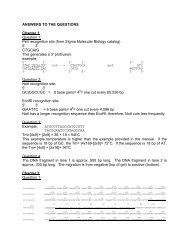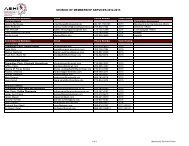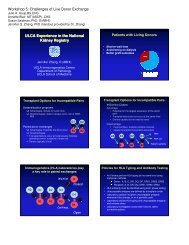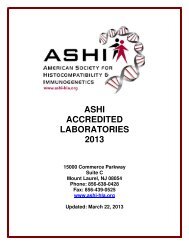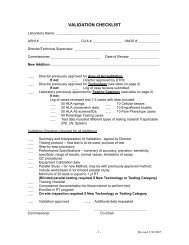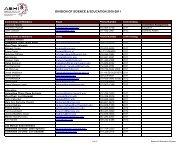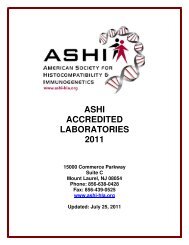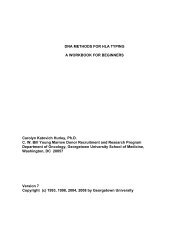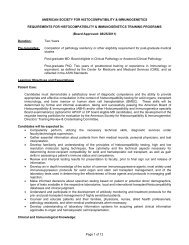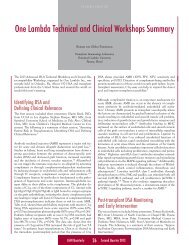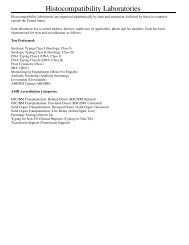eads. Comparing PS beads and TL beads, we found that 92.5% of the reaction patterns were in agreement.In contrast, only 15.2% of positive sera showed agreement between OL beads and PS beads.Conclusions: PS beads and TL beads generally agreed well. About half of positive sera on OL beads didnot react with PS or TL beads. Most discrepancies were from MICA*019 or MICA*<strong>00</strong>1 beads. Serumexchange and antibody absorption studies could be used to better characterize the antibodies against MICAand their serologic patterns.15-ORA MULTI-SITE STUDY EMPLOYING HIGH RESOLUTION HLA GENOTYPING BY NEXTGENERATION 454 GS FLX SEQUENCING.Cherie L. Holcomb 1 , Bryan Höglund 1 , Matthew W. Anderson 2 , Lisbeth A. Blake 3 , Irena Böhme 4 , MichaelEgholm 3 , Deborah Ferriola 5 , Christian Gabriel 6 , Damian Goodridge 7 , Rolf Klein 8 , Martha Ladner 9 , CurtLind 5 , Dimitri Monos 5 , Marcelo Pando 2 , Johannes Pröll 6 , David C. Sayer 7 , Gudrun Schmitz-Agheguian 10 ,Birgitte B. Simen 3 , Bernhard Thiele 8 , Elizabeth Trachtenberg 9 , Dolly B. Tyan 2 , Ralf Wassmuth 4 , ShanaWhite 9 , Henry A. Erlich 1 . 1 Roche Molecular Systems, Pleasanton, CA, USA; 2 Stan<strong>for</strong>d University,Stan<strong>for</strong>d, CA, USA; 3 454 Life Sciences-A Roche Company, Bran<strong>for</strong>d, CT, USA; 4 DKMS Life Sciences,Dresden, Germany; 5 Children’s Hospital of Philadelphia, Philadelphia, PA, USA; 6 Blutzentrale, Linz,Austria; 7 Conexio Genomics, Perth, Australia; 8 Institute of Immunology and Genetics, Kaiserslautern,Germany; 9 Children’s Hospital of Oakland, Oakland, CA, USA; 10 Roche Applied Science, Penzberg,Germany.Aim: The 454 GS FLX massively parallel pyrosequencing system is capable of providing high resolutionHLA genotyping <strong>for</strong> multiple individuals at multiple loci in a single run using the Conexio Genomics ATFsoftware. The clonal property and long sequence lengths of this system reduce genotype ambiguities. Toassess the reproducibility and accuracy of genotyping we per<strong>for</strong>med a multi-site study.Methods: To achieve high throughput genotyping, we used PCR primers with multiplex identifier (MID)tags to amplify HLA exons from individual samples, thereby allowing pooling of the amplicons generatedfrom different individuals prior to the emulsion PCR step. The MIDs allow the software to assign alleles inthe sequence files to the appropriate individuals. We per<strong>for</strong>med a double blind study in which 8 laboratorysites with varying levels of experience in sequencing on the 454 GS-FLX plat<strong>for</strong>m used GS-FLX standardchemistry and genotyped the same 20 samples <strong>for</strong> HLA-A, -B, -C, DPB1, DQA1, DQB1, DRB1, and DRB3, 4, 5 using the Conexio ATF software. Fourteen primer pairs (exon 2, 3, and 4 <strong>for</strong> class I, exon 2 <strong>for</strong>DPB1, DQA1, and the DRB loci and exons 2 and 3 <strong>for</strong> DQB1) with 11 MID tags were used.Results: The average sequence read length was 250 bp and the average number of sequence reads peramplicon was 672, providing confidence in the allele assignments. Of the 1280 genotypes considered,assignment was possible in 95% of the cases. Failure to assign known genotypes was the result ofprocedural error or presence of a novel allele. Overall concordance with known genotypes, in cases whereassignment was possible, was 97.2%. Overall concordance with known alleles was 98.3%.Conclusions: Genotyping using the GS-FLX system and Conexio ATF was very reproducible andaccurate. Further studies are underway to implement the use of GS-FLX Titanium chemistry and ConexioATF to provide even higher resolution HLA genotyping.16-ORDETECTION AND CHARACTERIZATION OF NON-IgG ANTIBODIES BY FLOWCYTOMETRY ANALYSIS OF MULTIPLEX BEAD ARRAYS.Nancy M. Tcheou, Aaron T. Whiteley, Lee Ann Baxter-Lowe. Surgery, UCSF, San Francisco, CA, USA.Aim: Microparticles with unique internal fluorescence, coated with purified HLA antigens are usuallyinterrogated <strong>for</strong> bound IgG using a phycoerythrin (R-PE) conjugated antibody. This only allows <strong>for</strong>analysis of one antibody isotype per test despite documented prevalence of IgA and IgM. This studydetermined feasibility of using multiple fluorescent parameters to quantify HLA-specific antibodies ofmultiple isotypes.Methods: Sequential sera of sensitized patients (n=173) with previously identified HLA antibodies byLabScreen Mixed Class I and II (One Lambda) were tested by LabScreen Single Antigen (One Lambda) todetermine antibody specificities and quantities according to the manufacturers’ recommended protocol.After analysis by Luminex 1<strong>00</strong>, the remaining Microparticles were divided and stained with FITC
conjugated IgM (BD Biosciences), IgA1, or IgA2 (both Southern Biotech). The microparticles wereacquired on a FACS Canto II and classified <strong>for</strong> their corresponding antigen. Correction <strong>for</strong> non-specificbinding was analogous to the HLA Fusion (One Lambda) <strong>for</strong>mula. The positive thresholds <strong>for</strong> themicroparticles were determined at 5 times the average standard deviation of no fewer than 2 negativecontrol sera <strong>for</strong> each isotype.Results: Using a very conservative threshold, the prevalence of HLA class I antibodies was 7%, 22%, and46% of sensitized patients <strong>for</strong> IgA1, IgA2, and IgM, respectively. The prevalence of Class II was 36%,11%, 21% <strong>for</strong> IgA1, IgA2 and IgM respectively.Conclusions: Using this method, it is possible to measure HLA specific non-IgG antibodies by usingmultiple fluorescent parameters to interrogate microparticles. By characterizing multiple antibody isotypessimultaneously we can increase access to data on non-IgG antibodies and better understand their impact onsolid organ transplantation.<strong>Monday</strong>, <strong>September</strong> <strong>27</strong>, <strong>2010</strong>2:<strong>00</strong> <strong>PM</strong> - 3:30 <strong>PM</strong>Abstract Session 2: Innate Immunity and Regulation17-ORHUMAN SEMAPHORIN 5A ACTS AS POTENT ACTIVATOR OF NK CELLS.Christiane Gras, Yarua Jaimes, Stephan Immenschuh, Rainer Blasczyk, Constanca Figueiredo. Institute <strong>for</strong>Transfusion Medicine, Hannover Medical School, Hannover, Lower Saxony, Germany.Aim: Semaphorins are a wide family of signaling molecules. Semaphorin 5A (Sema5A) and Sema7A areknown to regulate axon guidance. Sema7A has been shown to modulate the T and NK cell-mediatedimmune response. The role of Sema5A in the immune system is unknown. Here, we investigated theinfluence of Sema5A on NK cell function.Methods: The extracellular domain of Sema5A was expressed as soluble His-tagged protein in HEK cellsand purified by immobilized-metal affinity chromatography. NK cells were isolated from peripheral wholeblood of healthy donors and stimulated with Sema5A at a concentration of 10mg/ml during 48h. Sema5Astimulated and non-stimulated NK cells were analysed <strong>for</strong> phenotype changes in the surface expression ofKIR2DL1, KIR2DL2, NKp30, NKp44, NKp46, NKG2A, NKG2D, CD25 and CD69 receptors using flowcytometry. The cytotoxic potential of NK cells was analysed by measuring granzyme B production by realtime PCR and killing rates of K562 target cells by FACS. For all assays heat-denatured Sema5A was usedas negative control.Results: Sema5A stimulation induced an increase of the frequency of NKp44+ NK cells by up to 94%. Inaddition, the NKG2A+ and NKG2D+ NK cell population increased by up to 44% and 7% respectively. Thefrequency of the early activation markers CD25 and CD69 increased by up to 2.4 fold and 4.3 fold,respectively. Interestingly, the upregulation of the NK cell receptors by Sema5A was decreased or evenabolished in presence of IL-2 and IL-15. This effect can be explained by the downregulation of theSema5A-receptor Plexin-B3 by up to 95% observed upon IL2 and IL15 stimulation. Furthermore, uponstimulation with Sema5A, granzyme B mRNA levels were increased by up to 70% and the cytotoxicactivity of NK cells was increased by up to 20%.Conclusions: These results show <strong>for</strong> the first time that Sema5A is a potent activator of NK cells in vitroand demonstrate that it may play an important role in immune cell regulation.18-ORG-CSF: A STRONG INHIBITOR OF NK CELL FUNCTION.Laura Schlahsa, Yarua Jaimes, Rainer Blasczyk, Constanca Figueiredo. Institute <strong>for</strong> Transfusion, HannoverMedical School, Hannover, Lower Saxony, Germany.Aim: The human cytokine granulocyte-colony stimulatory factor (G-CSF) has found widespreadapplication in the medical treatment of neutropenia and to mobilise haematopoietic stem cells (HSC) used<strong>for</strong> transplantation purposes. So far, the effect of G-CSF on Natural Killer (NK) cells, which play a pivotalrole in haploidentical HSC transplantation, has not been fully investigated.
- Page 1 and 2: Monday, September 27, 20102:00 PM -
- Page 3 and 4: 5-ORTWO CASES OF DONOR SPECIFIC ANT
- Page 5 and 6: Monday, September 27, 20102:00 PM -
- Page 7: Results: PHA-induced mRNA expressio
- Page 11 and 12: Methods: Peripheral blood and endom
- Page 13 and 14: Aim: NK cells have an established r
- Page 15 and 16: Methods: Sera (n=22) were tested fo
- Page 17 and 18: expression on lymphocytes, we hypot
- Page 19 and 20: Conclusions: Clean SA beads can eli
- Page 21 and 22: goal is to re-examine our previous
- Page 23 and 24: Aim: There is increasing evidence t
- Page 25 and 26: esult in poor graft survival. The g
- Page 27 and 28: Aim: Pronase treatment eliminates i
- Page 29 and 30: 34-PCLINICAL AND PATHOLOGICAL SIGNI
- Page 31 and 32: Nabil Mohsin, Isabelle G. Wood, Ind
- Page 33 and 34: donor/recipient pairs for transplan
- Page 35 and 36: and tested in the DynaChip assay fo
- Page 37 and 38: average difference between Ave and
- Page 39 and 40: Conclusions: The XM-One assay can b
- Page 41 and 42: 59-PCYTOTOXIC AND NON-CYTOTOXIC ANT
- Page 43 and 44: data suggests that DTT pretreatment
- Page 45 and 46: Bhavna Lavingia 1 , Chantale Lacell
- Page 47 and 48: ATG INTERFERNCE IN SINGLE ANTIGEN L
- Page 49 and 50: 75-PPREFORMED LOW REACTIVE ANTI-HLA
- Page 51 and 52: Sabarinathan Ramachandran 1 , Naohi
- Page 53 and 54: 83-PALLELIC DIVERSITY OF KIR2DL4 AN
- Page 55 and 56: São Paulo, Brazil; 3 Commissariat
- Page 57 and 58: 91-PCHARACTERIZATION OF COMMON AND
- Page 59 and 60:
Conclusions: The extensive diversit
- Page 61 and 62:
99-PPOTENTIAL COMMON NOVEL ALLELES
- Page 63 and 64:
103-PTOWARDS A FUNCTIONAL HLA-DPB1
- Page 65 and 66:
107-PWHOLE GENOME AMPLIFICATION (WG
- Page 67 and 68:
111-PLOSS OF MISMATCHED HLA IN FAMI
- Page 69 and 70:
115-PDONOR EPITHELIAL CELL CHIMERIS
- Page 71 and 72:
Caucasian patients. MRs vary signif
- Page 73 and 74:
Results: We obtained the total No.
- Page 75 and 76:
cord blood and platelet transfusion
- Page 77 and 78:
131-PASSOCIATION OF IL-2-330(G/T) W
- Page 79 and 80:
Institute, Children’s Hospital Oa
- Page 81 and 82:
Methods: To prove the robustness of
- Page 83 and 84:
populations.We studied the involvem
- Page 85 and 86:
amplicons generated from different
- Page 87 and 88:
Results: The sequence of the unexpe
- Page 89 and 90:
concentration of the Taq Polymerase
- Page 91 and 92:
160-PASSOCIATION OF HAPLOTYPES WITH
- Page 93 and 94:
164-PDETECTION OF A DE NOVO DONOR S
- Page 95 and 96:
168-PA NOVEL HLA-DQB1 ALLELE CONFIR
- Page 97 and 98:
172-PSCREENING FOR HLA-SPECIFIC ALL
- Page 99 and 100:
176-PIMPLEMENTATION OF THE WORLD HE
- Page 101 and 102:
epertoire of displayed ligands and
- Page 103 and 104:
mucosa. No other samples were avail
- Page 105 and 106:
Conclusions: In previously reported
- Page 107 and 108:
Conclusions: Our findings can demon
- Page 109 and 110:
Conclusions: In analyzing this data
- Page 111 and 112:
examined on microarrays from a huma
- Page 113 and 114:
Methods: Serial analysis of sera ob
- Page 115 and 116:
Conclusions: These new technologies
- Page 117 and 118:
allograft injury. Four of these 18
- Page 119 and 120:
A NOVEL HLA CLASS I SINGLE ANTIGEN
- Page 121 and 122:
Results: Approximately twice as man
- Page 123:
Methods: Molecular HLA typing was p



